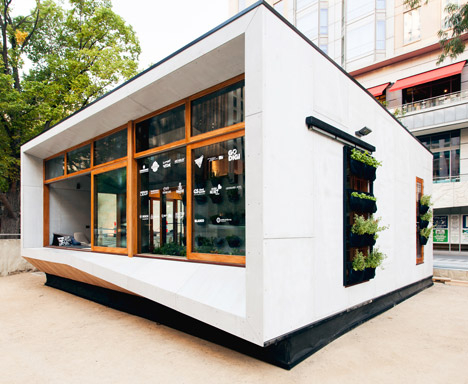Pro-carbon house on debut
 A building plugged as Australia’s first carbon positive prefab home has been on display in Melbourne.
A building plugged as Australia’s first carbon positive prefab home has been on display in Melbourne.
Design firm ArchiBlox has had its Carbon Positive 01 project on display as part of The New Joneses and the Sustainable Living Festival.
“Carbon positive moves beyond carbon zero by making additional ‘positive’ or ‘net export’ contributions by producing more energy on site (or through affiliated schemes), than the building requires and feeding it back to the grid,” a company spokesperson said.
The 77 square metre homes use a simple rectangular shape on one level, featuring a single bedroom, bathroom, a kitchen, a dining room, and a living room.
The house has a conservatory oriented to the north that is “not only a place to buffer the external environment, but a place to grow vegies, to relax, unwind,” the company says.
The conservatory features a “passive solar design”, which stores thermal mass and releases heat during cooler months.
Its green roof provides insulation and carbon storage, while an earth berm design on the southern facade insulates the house as well.
Cooling tubes embedded in the floor transmit air from the cooler south side to warmer areas.
“Our carbon neutral materials are complemented by the internal vegetable gardens – watered with our recycled grey water system – and the evaporative coolers, which use a combination of natural airflow and recycled plastic bottle pockets,” the spokesperson noted.
ArchiBlox says the house has undergone a Life Cycle Assessment (LCA), which calculates the building’s carbon emissions from the full length of its construction, including materials’ manufacture, materials’ transport, the materials themselves, building operation, and ongoing maintenance.
The experimental home was found to save the equivalent of 659 kilograms of carbon dioxide per year per occupant, a 116 per cent improvement on the traditional dwelling.
As the homes are prefabricated, costs are competitive with similar traditional houses.
Architect and company director Bill McCorkell said prefab is gaining popularity due to “the control owners have over the notorious twin building variables of time and cost.”
It is a very valuable niche.
The Asia-Pacific market for prefabricated buildings is worth around $US44 billion, about 49 per cent of the $90 billion worldwide prefab market.
A recenty report by McGraw-Hill Construction found that “prefabrication/modularisation are seeing a renaissance as technologies, such as BIM, have enabled better integration of prefabricated/modular components.
“As changes in design such as the emergence of green have made certain advantages of prefabrication/modularisation more important; and as innovative offsite techniques have emerged.”







 Print
Print